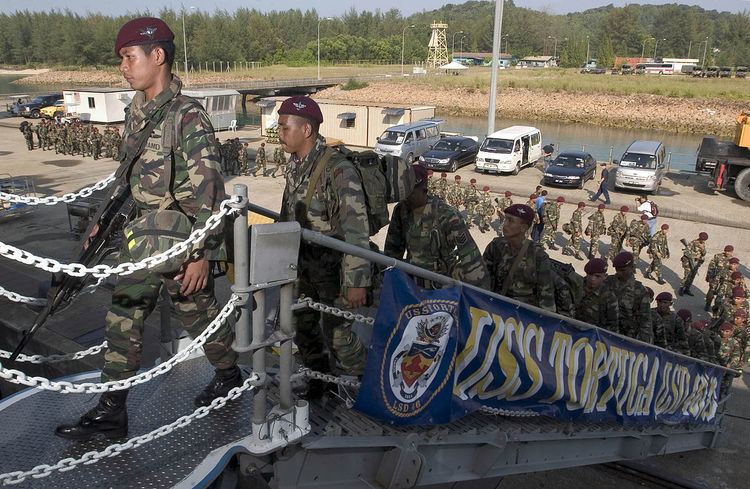Active 1970s – present Branch Malaysian Army | Country Malaysia | |
 | ||
Type Elite Airborne Infantry, Rapid deployment force Role Air Assault, Coastal Operations, Heli Operations, Spearhead Operations, Raids, Vertical Envelopment Forced Entry Part of Malaysian Armed Forces,
Malaysian Special Operations Force | ||
The 10 Parachute Brigade (Malay: 10 Briged Para, Jawi:10 بريڬيد ڤارا) - commonly known as 10th Para - is an elite airborne brigade-sized unit within the Malaysian Army tasked with being rapidly deployed inside or outside the boundaries of Malaysia. 10th Para is the key element of the Malaysian Rapid Deployment Force (Malay: Pasukan Aturgerak Cepat; PAC).
Contents
Origin
10th Para's primary role is to be the nation's main offensive force in time of war or emergencies. The creation of the Parachute Brigade was proposed by Malaysia's defence planners in the late 1970s as a part of the modernisation plan for the military. The plan originally did not receive much support from the government due to concerns that the formation of such a brigade would be looked with suspicion by its neighbour, Singapore.
In November 1988, Malaysia was unable to respond to a request for assistance by Maldives when that country was invaded by Tamil mercenaries. This inability to render timely help prompted Malaysian leaders to move to form paratrooper units within the Malaysian Army.
Timeline
Roles
10 Paratrooper Brigade is highly skilled in accordance with its status as a Rapid Deployment Force. Paratroopers are vigorously trained for specialised combat operations and rapid deployment in alignment with the brigade's motto -Tindak Pantas (English: Act Fast).
Identities
Brigade composition
10 Paratrooper Brigade is based at Terendak Camp, Malacca, also known as 'Home of the Paras'.
The brigade consists of:
Training
Members of the brigade must pass a basic Airborne Course and Rapid Deployment Force Orientation Course (Kursus Asas Pasukan Aturgerak Cepat) before being qualified to wear the maroon beret and parachute wing.
Many of the qualifying tests include: marches, raids, escape and evasions, abseiling, rappelling, mounted Gunung Ledang, survival skills, navigation, boating, running, and armoury dexterities.
These were designed to mentally and physically test candidates for jump qualifications.
Basics for specialists include:
- Tactical Air Landing Operations (TALO)
- Parachute course
- Close Quarters Combat (CQC)
- HALO/HAHO
- Sniper course
- Demolition expert
- Marksmanship
- Sharpshooters etc.
Recent Operations
The unit has been deployed in the following operations:
On 14 October 2005, The Malaysian Medical Team (MasMedTim) soldiers serving in earthquake-hit Battagram, Pakistan have been recommended for a service allowance of RM100 a day. The team, which left for Pakistan had set up a field hospital in Battagram, some 250 km from Islamabad, on 26 October. Equipped only with tents that were more suitable for the tropics and kerosene heaters, MasMedTim soldiers had to battle subzero temperatures while carrying out their duties of providing aid to survivors of 8 October South Asia earthquake. Insufficient winter clothes and the lack of hot water at the campsite was affecting soldiers for over two months now as the temperature sometimes dropped to minus-7 degrees Celsius at night.
The security surveillance, code-named Operation Padanan Sipadan Island Resort or known as Ops Pasir, which was launched on 20 September 2000 following the hostage-taking incidents in Sipadan and Pandanan islands, had restored confidence among tourists, including from the United States, to come to the resort islands. The integrated operation involves the Malaysian army, navy and air force as well as other related agencies such as the police and the coast guard.
